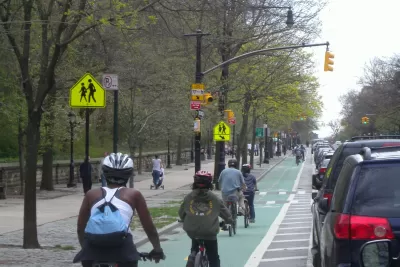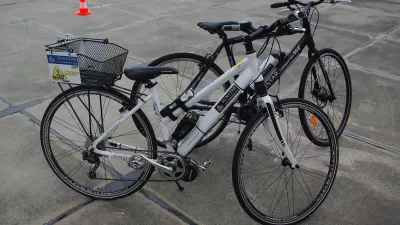Riders of electric and non-electric bikes alike agree that they would ride more if they felt safer on city streets, signaling a need for an increased focus on bike infrastructure.

“With battery-powered motors that assist riders as they pedal, e-bikes enable a broader range of people to make more and longer trips than traditional bikes. And they are cheaper, more efficient, and less resource-intensive to manufacture than electric cars.” Like electric cars, e-bikes require infrastructure improvements to make their widespread use practical and safe.
“There is no great mystery in how to get more people to ride e-bikes (as well as traditional bikes),” writes Ira Boudway in Bloomberg. “In polling commissioned by the advocacy group PeopleforBikes in 2018, nearly 70% of respondents across eight U.S. cities said that roads are not safe enough for families to bike and, of those, 63% said they would ride if they felt safer.” Research shows that “In city after city, when protected bike lanes are added to roadways, ridership increases.”
New bike infrastructure doesn’t have to be expensive, notes Boudway. “Fortunately, thanks to decades of spending on road and highway building, the infrastructure needed to create these networks already exists. Cities don’t need to pour asphalt; they just need to commandeer some of the surplus of streets from cars.”
Boudway points out that a majority of Americans support more bike and pedestrian infrastructure when polled, yet progress remains painfully slow as city leaders give in to the NIMBY minorities who protest loudest.
FULL STORY: How to Make a City Safer for E-Bikes? Think Infrastructure

Alabama: Trump Terminates Settlements for Black Communities Harmed By Raw Sewage
Trump deemed the landmark civil rights agreement “illegal DEI and environmental justice policy.”

Planetizen Federal Action Tracker
A weekly monitor of how Trump’s orders and actions are impacting planners and planning in America.

Why Should We Subsidize Public Transportation?
Many public transit agencies face financial stress due to rising costs, declining fare revenue, and declining subsidies. Transit advocates must provide a strong business case for increasing public transit funding.

Understanding Road Diets
An explainer from Momentum highlights the advantages of reducing vehicle lanes in favor of more bike, transit, and pedestrian infrastructure.

New California Law Regulates Warehouse Pollution
A new law tightens building and emissions regulations for large distribution warehouses to mitigate air pollution and traffic in surrounding communities.

Phoenix Announces Opening Date for Light Rail Extension
The South Central extension will connect South Phoenix to downtown and other major hubs starting on June 7.
Urban Design for Planners 1: Software Tools
This six-course series explores essential urban design concepts using open source software and equips planners with the tools they need to participate fully in the urban design process.
Planning for Universal Design
Learn the tools for implementing Universal Design in planning regulations.
Caltrans
Smith Gee Studio
Institute for Housing and Urban Development Studies (IHS)
City of Grandview
Harvard GSD Executive Education
Toledo-Lucas County Plan Commissions
Salt Lake City
NYU Wagner Graduate School of Public Service





























